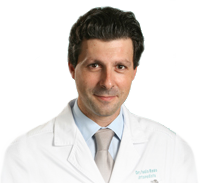- /
- Técnicas cirúrgicas /
- Osteotomia periacetabular “Bernese”
"Bernese" periacetabular osteotomy
The "bernese" or Ganz periacetabular osteotomy has been used in reference medical centers (in conservative hip surgery) to correct dysplasia and prevent the onset of osteoarthritis. (see section "Hip dysplasia and femoroacetabular impingement").
It is an osteotomy with a polygonal shape that is carried out in a precise way around the acetabular cavity separating it from the rest of the bone and allowing its re-orientation in the space (video 1 and 2). This surgery has advantages over other procedures as it allows large amplitude corrections, treating dysplasia and other deformities of the femoral head simultaneously (see section "Hip dysplasia and femoroacetabular impingement") and does not alter significantly the shape of the pelvis not interfering with the dimensions of the birth canal (may allow in female patients a normal delivery).
The technical complexity is related to the precision of the cuts, preservation of bone arterial vascular supply and accurately fixing bone fragment in the ideal position.
The surgical procedure requires specific tools, specially designed to that effect
The first cut is made underneath and behind the hip a pelvis region called "ischium" (fig. 1) with the aid of a specific instrument.
| fig. 1: The first cut is made with a special curved instrument in ischium passing behind the hip and the acetabular cavity. On the left view as if we were looking from within the pelvis, on the right as if we were looking from behind and out. | |
The second cut is then made in the pubis (fig. 2)
| fig 2: O The second cut is made in the pubis with direct control and protection of nerve structures |
The third cut, the most complex (fig. 3), is done in the iliac wing so to join the first. The fragment is thus free and can rotate in the space (fig. 4)
| fig 3: he top cut is the most complex, requires great precision so that its lower extension comes to join the first. The fragment is separated with the aid of special forceps, and then it is rotated to the optimum correction position. A control radiograph is always made prior to definitive fixation. | |
| fig. 4: The re-orientation of the acetabular fragment is carried out with precision until the final clamping position with four screws or in more complex cases with a plate and screws. This fixation, extremely stable is secured by its polygonal shape. | |
During surgery, the joint can be opened from the front so as to expose the head and neck of the femur, treat any deformities, optimize the anatomy and improve function (fig. 5).
| fig 5: in this preparation we observed the wide exposure of the head and neck of the femur that this surgery allows (line drawn on cartilage). If there is a deformity type "cam” it can easily be treated in the same surgical procedure (see section "Hip dysplasia and femoroacetabular impingement"). | |
In addition to treating dysplasia (fig. 6), "bernese" osteotomy can be used to treat situations of retroversion when the acetabulum has normal dimensions, but is oriented posteriorly (fig. 7). The technique used to make the cuts and how to re-position the fragment differ from traditional surgery. For this reason it is called reverse periacetabular osteotomy (see section "Acetabular retroversion").
| fig 6: radiograph before and after surgery in a 38 years old patient with treated severe acetabular dysplasia and about 4 years of follow-up after surgery. Note the positive evolution of the right hip with significant improvement in joint space. | |
| fig 7: radiograph before and after surgery in a 27 years old patient with acetabular retroversion. Note that the intersection of the lines of the acetabular wall, which appears in the posterior spatial orientation, disappears with surgery and the anatomy becomes norma (see section "Acetabular retroversion"). | |
Recovery after this surgery typically involves a hospital stay of 5 to 7 days and the need to use crutches for about 6 weeks. The resumption of work is variable occurring on average within 8 weeks.
The complexity of this requires that the surgeon is quite familiar with the various meticulous steps and has expertise in pelvis surgery. The results are good in the long term, being the survival rate of the young hip and without degenerative changes, thus operated, greater than in any type of surgery using prosthesis.
Video 1: Periacetabular Osteotomy
The periacetabular osteotomy is a cut made in the pelvic bone around the acetabular cavity. Note in the red region at the top of the acetabulum which corresponds to the overloaded cartilage dysplasia. The osteotomy modifies the position of the cartilage and increases lateral coverage of the femoral head
Video 2: Rotation of the acetabulum
With the rotation of the acetabulum, the femoral head becomes more stable and the pressure exerted in cartilage is lower because the contact area becomes larger
Legal Notice
CirurgiaConservadoradAnca.com has been developed for the purpose of providing information on the various hip pathologies to patients, physicians and other healthcare professionals. The information contained in this website cannot replace a proper clinical assessment. May not in any way be used to make a diagnosis or suggest treatment. This website has no interest or is in any way associated with companies that sell medications or surgical equipment.
The content of the website is for informative purposes only and its use is the sole responsibility of users.
All submitted content is intelectual property of the author. It is expressly forbidden to copy and use without permission of the same.
It is not allowed to make connections to this website as well as framing, mirroring and link directly to specific subpages (deep linking) without the prior written consent of CirurgiaConservadoraAnca.com

